Frangipanis
BackFrangipanis have to be the ultimate tropical plant. Just saying the word evokes thoughts of sunny blue skies and balmy days relaxing by a pool. Enjoy them for their beautiful flowers but don’t forget to plant them where you can also appreciate their fabulous fragrance like near the front door or a bedroom window.
Frangipanis are small trees that make excellent feature trees with stunning flowers and a striking umbrella shape. With their small noninvasive roots they can be planted near buildings and swimming pools without any problems. They are also perfectly happy growing in pots.
Frangipanis mostly flower from summer to autumn and come in shades of white, yellow, orange, pink, red and all the bicolours and tricolours you can think of in between!
Frangipani Types
There are quite a few different species of frangipani and many different cultivars. The most commonly grown species in Australia is Plumeria rubra (and its many cultivars). It is the most cold tolerant which explains its broad spread mostly around coastal zones. In cooler areas like Perth or Sydney it will be completely deciduous but only semi-deciduous in warmer zones further north. Frangipanis can be grown further south, or inland, if planted in a warm spot with very good protection from frost and cold winds eg against a brick wall that traps heat.
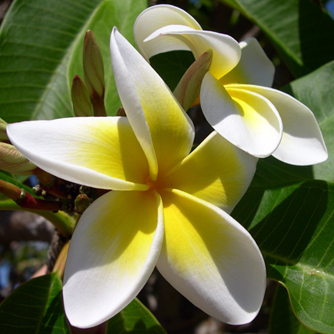
Iconic yellow and white frangipani flowers
Other species, like the evergreen Plumeria pudica and P. obtusa, need warmer conditions than P. rubra so their growing range is generally more restricted.
How To Grow Frangipanis
Choose a full sun, frost free position with good drainage. They will grow in quite sandy soils but it’s still a good idea to work in some compost or manure to improve nutrient levels. With a heavy clay soil apply some gypsum and mound the soil before planting to assist with drainage.
Plant to the same depth as it was in the container to avoid trunk rot and water in with OCP eco-seaweed. Keep any mulch away from the trunk, again to prevent trunk rot.
The best time to plant frangipanis is in the warmer months when they’ll establish quicker and are less likely to rot.
Fertilising & Maintenance of Frangipanis
Fertilise in spring and summer with some manure or an organic pelletised fertiliser. If you want to push more growth in a young plant then apply a mixture of OCP eco-seaweed and OCP eco-aminogro every fortnight as either a foliar spray or watered into the soil around the base.
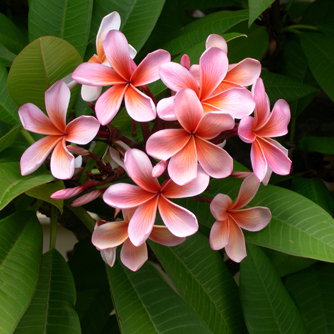
Pink with apricot centre frangipani flowers
Frangipanis require little ongoing maintenance and once established are quite drought tolerant. They naturally produce their distinctive umbrella shape without the need for pruning. In pots keep them on the dry side when dormant to prevent rot.
Frangipani Cuttings
Frangipanis grow easily from a cutting which can be just about any size. Anything from 30cm to 3m will reliably strike! Firstly take your cutting from a healthy branch and remove any flowers or leaves. Place it in a shady place where it will be kept dry for 1-2 weeks. This allows the end of the cutting to callous over and helps to avoid rotting. Then pot up your cutting using a good quality potting mix, water in with OCP eco-seaweed and place in a warm, sheltered position. Do not water again until new leaves appear or the potting mix becomes very dry. Large cuttings should be staked until they have developed a root system.
Cuttings can be taken at any time of the year but in winter they will be slow to form roots. This increases the risk of rotting due to overwatering so if you’re not really sure what you’re doing then just take cuttings during the warmer months.
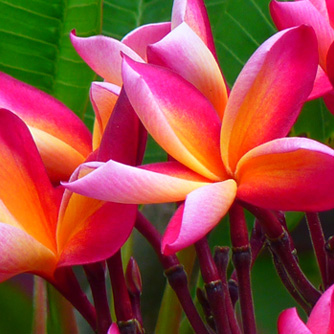
Intense pink and yellow frangipani flowers
Transplanting Frangipanis
Frangipanis transplant well even as large trees. Transplant in spring or summer keeping as many roots as possible. It is important to note that large trees are very heavy and their branches fairly brittle so care needs to be taken during the job. Staking afterwards is vital until the new roots have grown and established the plant. Maintain these supports for at least 12 months.
Water with OCP eco-seaweed every two weeks to reduce transplant shock and encourage new root development.
Pest and Disease Problems of Frangipanis
Frangipanis are usually trouble-free if grown in a warm location with good drainage. However here are a few things which can crop up:
- Mites – these tiny pests quickly suck sap out of the foliage causing the leaves to lose their greenness and become washed out. Thoroughly spray with OCP eco-oil or OCP eco-neem at the first sign of damage as mites breed very quickly. A follow up spray is recommended. If practical, increase humidity around plant as the mites like drier conditions.
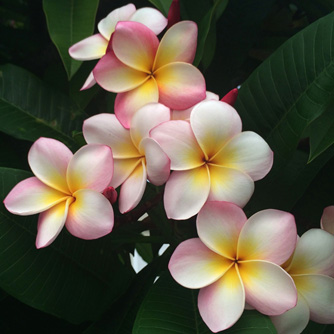
Soft pink, yellow and white frangipani flowers
- Scale - if small brown lumps appear on the stems, and they can be flicked off with your fingernail, then your plant has scale. Treat with sprays of horticultural oil.
- Rust – appears as small yellow patches on the upper leaf with distinct orange pustules on the underside of the leaf. In bad cases the pustules can appear on both sides. At the first sign of disease thoroughly spray with an organic fungicide. This disease appears later in the season as the frangipani slows down and gets ready to drop its leaves. Control at this stage is very difficult.
- Stem rot or Black tip – the fleshy branches are prone to several diseases that can turn them soft and mushy when the tree has been exposed to frost and cold weather, poor drainage or overwatering. Cut back the blackened stems to a healthy piece of trunk and spray OCP eco-seaweed as a foliar spray once a week until early summer. Improve cold protection, soil drainage and reduce excess watering.
- Stem dieback – similar to stem rot but in this case branches turn dry and papery as they die, rather than mushy. It’s a reaction to cold weather so try to increase protection around the tree. Prune away dead branches and spray regularly with OCP eco-seaweed to help boost cold tolerance. If growing a frangipani in a colder climate then you’ll always have some branch death. Keep the tree healthy during the warmer months with regular doses of OCP eco-seaweed and OCP eco-aminogro as a way to compensate against some limb loss during winter.
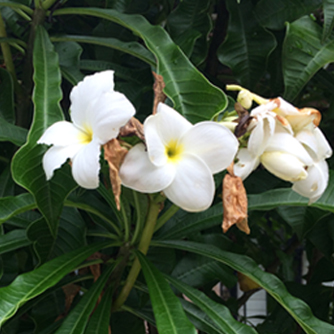
Less common Plumeria pudica with its distinctive evergreen flared leaves
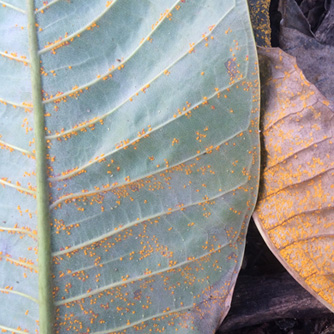
Badly infected leaf showing the distinct rust pustules on the leaf underside
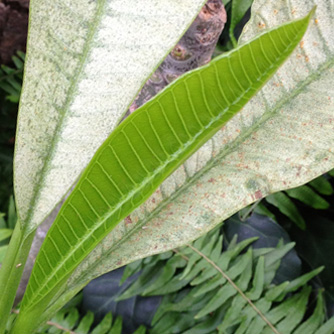
Mite damaged frangipani leaves compared with young undamaged leaf


